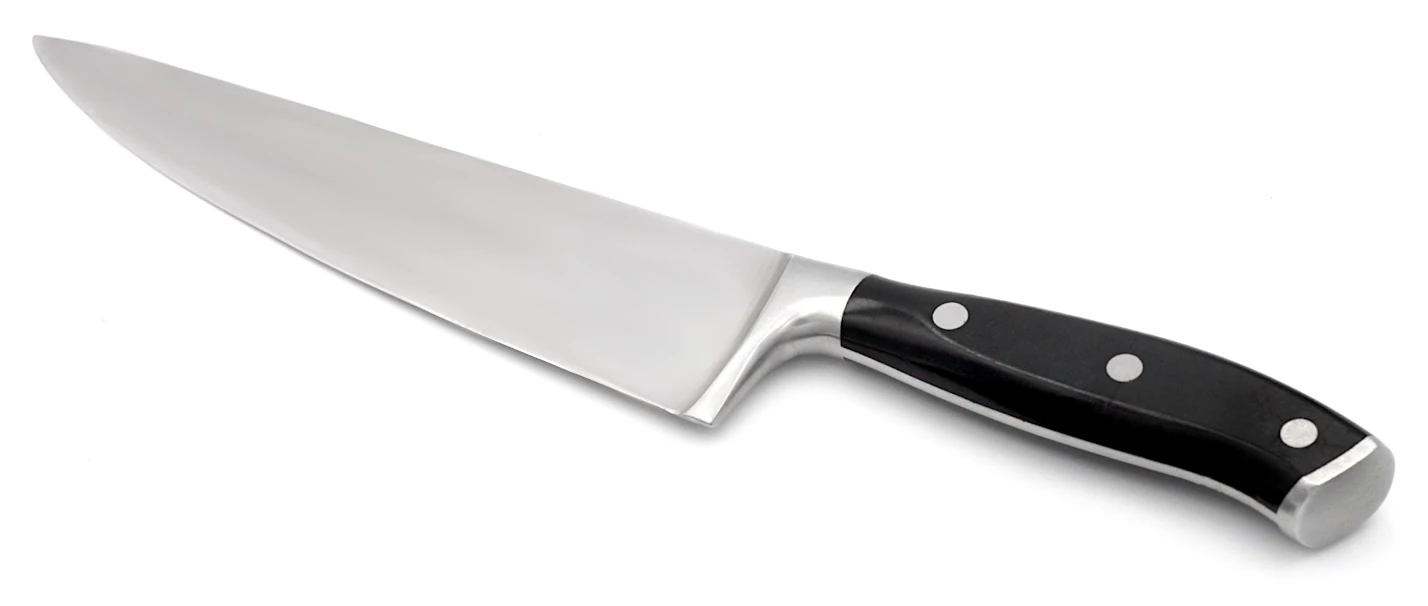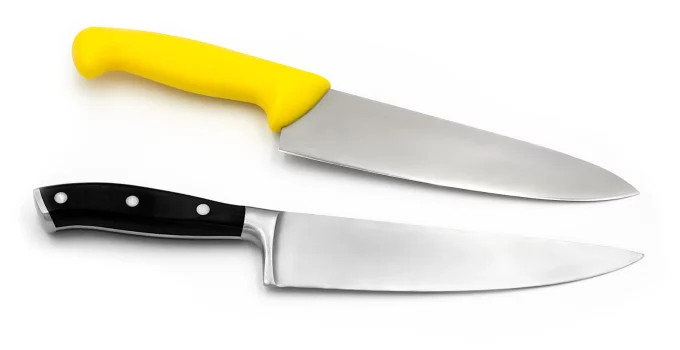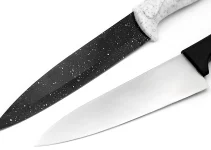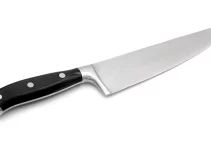Is it possible to find some amazing, razor-sharp, long-lasting edges for our kitchens when we’re shopping for the best chef’s knives under 50 dollars?
It totally is.
The most expensive knife I own is my chef’s knife. But that’s pretty much my exception in the kitchen. And I basically bought it as a present for myself and to see what the deal is all about with these famous brands.
I was blown away, that’s for sure. It was love at first hold. However, as a rule, I don’t think that only the most expensive kitchen appliances are the best choice for us.
Whether I’m talking about blenders, toasters, juicers, air fryers, cookware sets, and many other kitchen appliances, tools, and utensils I almost never go for the most expensive models as my top and favorite recommendations.
Firstly, it’s because when I’m reviewing products I want everyone, no matter their budget, to be able to choose something that has the potential to be amazing.
Secondly, I rarely buy the most expensive products for myself. Sometimes, I make exceptions but that mostly applies to a few tools that truly are my passion, like my expensive chef’s knife.
I also own other chef’s knives that are a lot cheaper and I think that, as long as we maintain a razor-sharp edge, even a more affordable option can compete with a very expensive blade.
Best Chef’s Knives Under 50 Dollars

Whenever I think of affordable knives that, in my opinion, could very well stand up to Wusthof, I immediately think of Victorinox.
It’s one of my favorite brands in this market and one of the most popular. I truly love their knives, whether we’re talking about chef’s knives, bread knives, butcher knives, fish fillet knives, etc.
However, there are a lot more brands to check out. Some even make chef’s knives as cheap as $20.
KitchenAid is a manufacturer to look for if you want quality knives that cost as little as $20.
By the way, if you decide that you would like something a bit more exotic but even more versatile than a chef’s knife, I recommend checking out my butcher knife vs cleaver comparison. You’ll find out that cleavers can totally replace a chef’s knife, while being capable of so much more.
1. Victorinox Fibrox Pro Chef’s Knife, 8-Inch: Overall the Best Knife Under $50
Let me start my reviews for the best chef’s knife under $50 with one of my favorite brands. It’s also one of the most popular chef’s knives on the market. Victorinox is an incredibly popular and well liked manufacturer.
I should also mention that this Victorinox Fibrox Pro Chef’s Knife is right around our price limit. Thus, if you are looking for a model well under $50, maybe around $20-$30, this one is not a good choice.
KitchenAid actually makes one of the cheapest chef’s knives and I will talk about it right below to contrast these two.
Features
The first thing I should mention is that we get a stainless steel blade. It should be easier to sharpen, can be sharpened to cut through anything with ease, it’s easy to maintain, and it has the possibility to last a lifetime.
As it says in the name, this Victorinox Fibrox Pro Chef’s Knife has an 8 inch (7.9 inch to be totally accurate) blade.
It’s not the smallest chef’s knife. That would be a 6-inch blade which is just too small to be on my list.
The 8-inch blade is described as being standard and it’s a decent size. It has a gentle curved edge that works for any chopping style.
However, if you are looking for a knife with a blade big enough to slice through very big pot roasts in a single, clean move, then you’ll need a 10 inch blade.
Overall, the 8 inch size is great for pretty much everyone. I would also argue that a 9 inch blade would be even better for some of us but those are pretty rare.
The Victorinox Fibrox Pro Chef’s Knife is described as extra wide. That makes it very good for scooping ingredients.
It has an ergonomically shaped plastic handle. You’ll love the feel of it. Once your hand gets used to it, you’ll barely feel it and you will be able to slice and dice no matter how many ingredients there are in front of you without exerting yourself.
Another important factor is the 6.1 oz weight. This is a lightweight chef knife, which most people will totally appreciate.
Overall, it’s easy to maneuver and it has a comfortable feel to it. It’s truly one of the best chef’s knives under 50 dollars.
Sharpness
Some would say that Victorinox knives are not as sharp as those from seriously more expensive brands like Mac or Wusthof.
The main difference between Victorinox and a much more expensive brand like Wusthof is that the blades for Victorinox knives are stamped. It’s a high-quality stamped knife that can compete with more expensive brands. The Wusthof models are forged.
I beg to differ because everyone who loves Victorinox will mention just how sharp their blades really are.
In my opinion, we can always expect razor-sharp blades straight out of the package.
However, I always recommend learning how to sharpen your knives at home if you want to maintain that razor-sharp edge indefinitely.
Starting every task with a razor-sharp edge prevents you from getting cut easily and ensures that you will finish your job quickly and with less effort. There’s nothing more frustrating than using a marginally dull blade.
Victorinox mentions that their Victorinox Fibrox Pro Chef’s Knife rarely requires sharpening. I mean, if you use it a couple of times a week for a few minutes, I agree.
But if you use it daily and cook for a family of 4 or bigger, then you need to sharpen it at least twice a month.
Some sharpen their knives every time before using them. You’ll feel when it needs a few touch ups.
Maintenance
The only recommendations we receive are: clean it immediately after use with mild soap and rinse it under running water, then dry well and store safely.
It is a stainless steel blade so, besides washing it by hand and thoroughly drying it immediately after, there’s not much you need to do.
2. KitchenAid Gourmet Chef Knife, 8-inch
KitchenAid makes a bunch of knives but we are primarily interested in the chef knives from them.
What you’ll notice immediately is that this is a very affordable knife.
It’s one of the cheapest chef’s knives on the market, with a price around $20. I mean, I don’t think it gets cheaper than this if we want a quality blade.
The manufacturer describes it as a workhorse of the kitchen. It’s ideal for slicing, dicing and chopping.
High-carbon steel blade
The impressive thing about this cheap chef’s knife from KitchenAid is that this is a forged knife from semi-polished, high-carbon Japanese steel.
So, we don’t have a stainless steel knife like it is the case with the Victorinox I reviewed above but this KitchenAid Gourmet Chef Knife is a carbon steel knife.
I wanted to highlight this distinction because carbon steel can rust and it can stain easily.
These types of blades are razor-sharp and they can presumably maintain that sharpness for longer but they’re also a bit more high-maintenance.
Maintenance
The first thing you should do when you receive this KitchenAid, if you decide to keep it, you must force a patina onto the blade to protect it from rust.
You can rub instant coffee, vinegar or potatoes onto the blade and polish them in.
Experts recommend washing the blade immediately after using it.
Then, dry it completely.
And oil it with food-grade mineral oil. For durability, oiling the blade will help it maintain a good shine and it will protect the blade.
And don’t place your knives into a knife block.
This one comes with a blade cover.
On the other hand, you can disregard my advice because KitchenAid mentions that their knives are top rack dishwasher safe.
They also state that to extend their lives, hand washing is recommended. Dry it immediately after.
Handle
There are two handles we can choose from: one that features a brushed stainless steel finish and another that is a classic black handle with a stainless steel endcap. Both look good.
The handles are ergonomic and easy to use. They offer a secure, comfortable grip.
3. Rada Cutlery French Chef Knife, 8.5 Inch
Rada Cutlery manages to achieve a lot of things with their French chef knife. It’s going to be a joy to review.
The price is around $30-$40 so it’s a very affordable knife.
It also has a very beautiful design.
In terms of quality, I would say that we can potentially get more than what we pay for it.
High-carbon stainless steel blade
The blade is made from T420 high-carbon stainless steel.
It is hand-sharpened and the sharpness is on point. We get a razor-sharp edge that is a delight to use. It’s simply a joy using this knife.
The high-carbon steel is used by Rada Cutlery to ensure durability.
Carbon steel needs a bit more maintenance than stainless steel so you should read a bit about how to take care of carbon steel knives.
Like all chef’s knives, the blade is wide so it can crush garlic and it can help you to transfer ingredients from the cutting board to wherever you want them.
8.5 inch blade
It’s rare to see a Western chef knife that doesn’t have an 8 inch or 10 inch or 12 inch blade length.
Rada Cutlery decided to make something in between, constructing this 8.5 inch long blade, which I really like.
It might be the perfect length for a lot of people.
Another thing to mention is that this knife is made in the USA. That’s not something we come across often.
The handle is a brushed aluminum handle. It makes the entire knife stand out and look striking. It’s a gorgeous knife with all the right attributes.
4. J.A. Henckels International Premio 8-Inch Chef Knife
With a price around $40, we can certainly describe this J.A. Henckels International Premio 8-Inch Chef Knife as one of the best chef’s knives under 50 dollars.
J.A. Henckels belongs to Zwilling.
Stainless steel blade
Just like Victorinox, this J.A. Henckels International Premio 8-Inch Chef Knife is also made of stainless steel.
This is forged stainless steel. It’s a patented special formula, rust resistant.
It’s easy to take care of. Just wash it by hand and dry it immediately after and completely.
The manufacturer mentions that the stainless steel construction creates a highly durable knife designed for long term sharpness.
It has a satin finish for a glossy appearance.
The handle is ergonomic with a comfortable grip and it’s the classic triple rivet handle.
All in all, we get a knife that offers a comfortable grip, a razor-sharp blade straight from the packaging, and the potential to use this knife for a very long time.
Of course, if you want to maintain the razor-sharp sharpness, you’ll have to sharpen it often.
5. Mercer Culinary Genesis 9-Inch Chef’s Knife
This manufacturer doesn’t make it easy to choose the right chef’s knife for us. Thankfully, we have a budget that we must respect so that is going to eliminate plenty of Mercer Culinary’s models.
They have some knives that have similar prices to what Wusthof offers, around $160-$180. They also have some that cost around $60-$100. Thus, we have to eliminate all those many knives.
We’re left off with the Millenia series, the Ultimate White series, and the Genesis series.
Full admission: the Genesis 8-inch Chef’s Knife is below $50 so you can go for that size and still be well within budget if Mercer Culinary is a brand that you really like.
However, I want to focus on the Mercer Culinary Genesis 9-Inch Chef’s Knife because we rarely see a 9-inch blade for Western chef knives. Its price is just a couple of dollars above our limit.
9-inch blade
If you’ve owned an 8 inch blade and you felt that it turns out to be just a bit too short, we get the chance to buy a 9-inch chef’s knife and it’s not a gyuto (Japanese-style chef knife).
I think that this 9 inch blade can be such an awesome size for a lot of us.
The Genesis series also has other sizes: 6, 8, and 10 inches.
High carbon steel
The knife is precision-forged with high-carbon German steel.
Mercer Culinary tells us that this high-carbon German steel helps it resist staining, corrosion, and discoloration. I would like to remind you that carbon steel is more vulnerable to all these weaknesses if we compare it with stainless steel.
The taper-ground edge allows for increased efficiency when cutting along.
The sharpness is on point. How often you’ll end up sharpening it at home depends on how often and for how long you use it. If you use it often, you’ll probably have to sharpen it 1-2 times per month.
The handle is non-slip and it has an ergonomic easy-grip design. It makes it easy to use, it’s comfortable.
6. Mercer Culinary Ultimate White: Cheap Chef’s Knife
I know that we’re here to talk about the best chef’s knives under 50 dollars but how would we feel if you could buy an 8-inch chef’s knife for about $13 or for a price under $20?
The Ultimate White series is one of the cheapest we could ever find, while still expecting some good quality, durability, and sharp edge.
Blade size
The cheapest we can choose for a satisfactory chef’s knife is the 8 inch blade. It’s very cheap.
We can also choose a 10-inch or a 12-inch model, both costing less than $30. The 10 inch is big and pretty nice but the 12 inch size might be a bit too much for me. I couldn’t get used to it.
Personally, I prefer the 8 inch blade as the easiest and fastest length blade to cut through any ingredients. So that’s great because the 8-inch is also among the most affordable options.
High-carbon Japanese steel
It seems that the cheap knives among my recommendations are actually made with high-carbon Japanese steel.
Mercer Culinary mentions that this material ensures easy edge maintenance and a razor sharp blade that lasts.
I would say that people should read about maintenance tips for carbon steel blades.
The handles are white for all sizes and I like their look.
They’re ergonomic and easy to use. They also offer textured finger points for non-slip grip with added comfort, durability, and safety.
The manufacturer describes the Ultimate White series as being a combination of quality, design, materials for the value minded kitchen. I would say that it’s fair advertisement.
Chef’s knife: the big knife in the kitchen
If we don’t take into account a cleaver, the chef’s knife is going to be the biggest knife in the kitchen. It’s also the most used one, the all-purpose kitchen tool.
Personally, I couldn’t imagine cooking without a chef’s knife. But that’s because I can’t get used to using a cleaver. If that were to happen, I probably couldn’t imagine myself cooking without both of them.
If you own absolutely no other knife, if you only want to buy one single knife for all your needs, you absolutely need to get a very good chef’s knife. Luckily, we’re here talking about the best chef’s knives under 50 dollars.
The second thing you have to take care of is to figure out how to keep the edge razor-sharp at all times.
If you manage these two, you can totally do 100% of everything you need to do in the kitchen with a chef’s knife. If we were to be realistic, I would say that a chef’s knife takes care of 90% of all cutting, slicing, dicing, mincing, chopping, smashing garlic etc.
We can even use a sharp chef’s knife to cut pizza so you can definitely skip on buying a pizza cutter wheel.
It is both the most important knife in the kitchen and, I would say, the most important tool in the kitchen.
Some would say that we need to spend at least $100-$150 on a good chef’s knife, although some can cost even $250.
I would say that amateur cooks with limited budgets shouldn’t be left out without any amazing choices for the most important tool in their kitchens. I hope my reviews here managed to prove that.
The anatomy of a chef’s knife
We’ve got a blade and a handle. But what characterizes the blade that makes this tool the most important in our kitchens?
The wide blade and the tip are perfectly designed to allow us that rocking back and forth type of mincing.
When I first saw the back and forth rocking executed by a chef, I knew that I had to learn to do that. I was mesmerized and I still am 20 years later.
The German style has a more curved section at the front of the blade. It’s very good for that rocking motion.
On the other hand, the French style is straighter and more triangular, which works perfectly for slicing where the knife is drawn straight back toward you.
The best blades are forged from a single piece of steel that runs the entire length of the knife. That’s exactly what Wutshof offers but it’s way above our $50 price limit.
High carbon stainless steel is the material that prevails. But stainless steel can be a very good option, too.
Nowadays, stainless steel knives are almost as good as carbon steel knives, with the difference that stainless steel doesn’t require much care and maintenance.
Ordinary carbon steel is a softer metal. That makes them easier to sharpen but they can also become dull more quickly.
If you know how to sharpen your own knife, choosing a stainless steel blade instead of a high carbon steel one won’t pose any problems.
Gyuto: the Japanese chef’s knife
We have Western chef’s knives, which can be also called French knives, and we have gyutos, which is the Japanese version of the classic Western chef’s knife.
Gyuto translates to mean “cow sword”. They were originally meant for slicing meat, beef in particular.
However, due to their sharp and large blade, they have evolved to be a multipurpose knife, just like our Western chef’s knives.
The blade of a gyuto might be slightly more sleek.
This multipurpose Japanese knife has an ultra sharp edge with a pointed tip, which is perfect for executing the rocking back and forth type of mincing.
Gyuto blades are made with high carbon Japanese steel, which is also used to make santoku knives.
High carbon Japanese steel is famous for creating a super sharp edge that is better for edge retention and it will withstand the taste of time. Some would say that high carbon Japanese steel is superior to other types of high carbon steel. I won’t say that it is or that it isn’t because I have no way of knowing for sure.
The balance point for a gyuto is generally further up on the blade’s edge, which can provide the cook with more agility and precision.
The blade of a gyuto might be slightly more sleek, it can be slightly lighter and thinner.
All in all, I equally love both the Japanese and the Western styles. I really don’t differentiate between the two. Whichever style you choose, it’s going to work great.
However, gyuto knives are generally more expensive than our limit og $50 so you’ll end up with a Western style.
Best Chef’s Knives Under $50 Buying Guide
What happens if you don’t like any of the chef’s knives that I reviewed above? In that case, you’ll need to do a bit more research by paying attention to a few important features.
Chef’s knife size
Let’s start off by answering an important question: how big should a chef’s knife be?
An 8-inch blade is the standard size for a chef’s knife. This is the size you’ll most frequently come across.
However, chef knives range from 6 inches up to 12 inches and more.
The 8-inch blade is among the most popular and it’s followed by the 10-inch blade. These blade measurements actually apply to a lot of different types of knives.
Some manufacturers will offer a variety of blade sizes: 6 inches, 8 inches, 9 inches, 10 inches, 12 inches. That can make things very confusing. When we have too many choices, we can easily become overwhelmed and lose patience.
If this is your absolute first chef knife, I would recommend choosing the standard 8-inch blade.
If you already know that you prefer larger blades, a 10 inch one can be an optimal choice. It will allow you to make longer single-stroke cuts.
However, a 9 inch blade might actually be the optimal blade length for most people.
Although, it’s quite puzzling to see that we seldom come across 9-inch chef’s knives when this blade size might actually be perfect for so many people.
6 inch blades are just too small to reach all the way across many foods, which is frustrating. For example, they’ll be too small to reach all the way across a pot roast.
Some gyuto knives don’t come in fixed 8 or 10 inch blades. Their blades measure 8.2, 9.45 or 10.5 inches.
Material
Knives are usually made from: high carbon steel, carbon steel or stainless steel.
Nowadays, there’s not that much difference between these 3 materials.
If we were to make a comparison between the 3, we would say that high carbon steel is considered to be the best because it has a razor-sharp edge that lasts the longest until we need to sharpen it. However, it’s also considered that it requires more maintenance.
Carbon steel, softer than high carbon steel, and stainless steel might be easier to sharpen.
And they also can have a really sharp edge so, if you know how to sharpen your own cutting tools, you’ll be pleased with these two materials.
Stainless steel doesn’t require maintenance because it doesn’t rust. In terms of durability, stainless steel blades might be the best because they don’t rust and don’t stain easily. Just make sure to dry them properly.
Carbon steel and high carbon steel are the two most popular choices for knife materials. It’s harder to find a stainless steel blade than it is to find the other two.
J.A. Henckels and Victorinox make stainless steel chef’s knives and they’re within our $50 budget. If you prefer stainless steel blades, these two might be among the few you’ll find.
When you’re looking for the best chef’s knives under $50, there’s a high probability that you’ll end up buying high carbon stainless steel blades.
Handles
According to theculinarypro.com, the best way to hold a chef’s knife is to grip the heel of the blade with your thumb and forefinger and wrap the remaining three fingers around the handle. This is the most comfortable hold and your hand won’t get tired easily. A good chef’s knife will guide you towards this hold automatically.
Last but not least, let’s talk about handles.
Handles were traditionally made of wood but wooden handles are porous so they can harbor bacteria.
I don’t recommend wooden handles for a chef’s knife. Moreover, wooden handles can warp or crack.
Wood that has been treated with plastic resin is an acceptable option.
All in all, the best chef’s knives under 50 dollars are going to have plastic (polypropylene ), rubber or even aluminum handles and they will offer a comfortable, non-slip grip even when wet.



